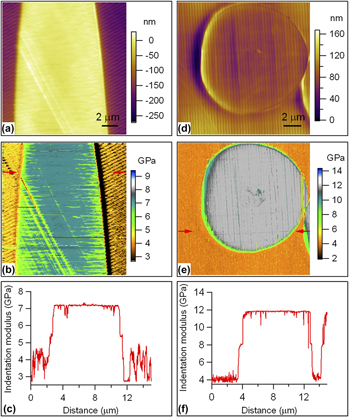Crossref Citations
This article has been cited by the following publications. This list is generated based on data provided by
Crossref.
McAllister, Quinn P.
Gillespie, John W.
and
VanLandingham, Mark R.
2013.
The influence of surface microstructure on the scratch characteristics of Kevlar fibers.
Journal of Materials Science,
Vol. 48,
Issue. 3,
p.
1292.
Wu, Xiawa
Moon, Robert J.
and
Martini, Ashlie
2013.
Crystalline cellulose elastic modulus predicted by atomistic models of uniform deformation and nanoscale indentation.
Cellulose,
Vol. 20,
Issue. 1,
p.
43.
McAllister, Quinn P.
Gillespie, John W.
and
VanLandingham, Mark R.
2013.
The sub-micron scale energy dissipative deformation mechanisms of Kevlar fibrils.
Journal of Materials Science,
Vol. 48,
Issue. 18,
p.
6245.
Gibson, Ronald F.
2014.
A review of recent research on nanoindentation of polymer composites and their constituents.
Composites Science and Technology,
Vol. 105,
Issue. ,
p.
51.
Cole, Daniel P.
and
Strawhecker, Kenneth E.
2014.
An improved instrumented indentation technique for single microfibers.
Journal of Materials Research,
Vol. 29,
Issue. 9,
p.
1104.
McAllister, Quinn P
Gillespie, John W
and
VanLandingham, Mark R
2014.
The energy dissipative mechanisms of particle-fiber interactions in a textile composite.
Journal of Composite Materials,
Vol. 48,
Issue. 28,
p.
3553.
Behlow, H.
Saini, D.
Oliveira, L.
Durham, L.
Simpson, J.
Serkiz, S. M.
Skove, M. J.
and
Rao, A. M.
2014.
Direct measurement of shear properties of microfibers.
Review of Scientific Instruments,
Vol. 85,
Issue. 9,
Atanasov, Sarah E.
Oldham, Christopher J.
Slusarski, Kyle A.
Taggart-Scarff, Joshua
Sherman, Shalli A.
Senecal, Kris J.
Filocamo, Shaun F.
McAllister, Quinn P.
Wetzel, Eric D.
and
Parsons, Gregory N.
2014.
Improved cut-resistance of Kevlar® using controlled interface reactions during atomic layer deposition of ultrathin (<50 Å) inorganic coatings.
J. Mater. Chem. A,
Vol. 2,
Issue. 41,
p.
17371.
Sockalingam, Subramani
Gillespie, John W.
and
Keefe, Michael
2014.
On the transverse compression response of Kevlar KM2 using fiber-level finite element model.
International Journal of Solids and Structures,
Vol. 51,
Issue. 13,
p.
2504.
Cole, Daniel P.
Riddick, Jaret C.
Iftekhar Jaim, H. M.
Strawhecker, Kenneth E.
and
Zander, Nicole E.
2016.
Interfacial mechanical behavior of 3D printed ABS.
Journal of Applied Polymer Science,
Vol. 133,
Issue. 30,
Wollbrett-Blitz, Judith
Joannès, Sébastien
Bruant, Rémi
Le Clerc, Christophe
Romero De La Osa, Marc
Bunsell, Anthony
and
Marcellan, Alba
2016.
Multiaxial mechanical behavior of aramid fibers and identification of skin/core structure from single fiber transverse compression testing.
Journal of Polymer Science Part B: Polymer Physics,
Vol. 54,
Issue. 3,
p.
374.
Stockdale, Taylor A.
Strawhecker, Kenneth E.
Sandoz-Rosado, Emil J.
and
Wetzel, Eric D.
2016.
A rapid FIB-notch technique for characterizing the internal morphology of high-performance fibers.
Materials Letters,
Vol. 176,
Issue. ,
p.
173.
Sockalingam, Subramani
Bremble, Reid
Gillespie, John W.
and
Keefe, Michael
2016.
Transverse compression behavior of Kevlar KM2 single fiber.
Composites Part A: Applied Science and Manufacturing,
Vol. 81,
Issue. ,
p.
271.
Sockalingam, Subramani
Chowdhury, Sanjib C
Gillespie, John W
and
Keefe, Michael
2017.
Recent advances in modeling and experiments of Kevlar ballistic fibrils, fibers, yarns and flexible woven textile fabrics – a review.
Textile Research Journal,
Vol. 87,
Issue. 8,
p.
984.
Sockalingam, S.
Casem, D.
Weerasooriya, T.
McDaniel, P.
and
Gillespie, J.
2017.
Experimental Investigation of the High Strain Rate Transverse Compression Behavior of Ballistic Single Fibers.
Journal of Dynamic Behavior of Materials,
Vol. 3,
Issue. 3,
p.
474.
Hardiman, M.
Vaughan, T.J.
and
McCarthy, C.T.
2017.
A review of key developments and pertinent issues in nanoindentation testing of fibre reinforced plastic microstructures.
Composite Structures,
Vol. 180,
Issue. ,
p.
782.
Sockalingam, Subramani
Gillespie, John
and
Keefe, Michael
2017.
Role of Inelastic Transverse Compressive Behavior and Multiaxial Loading on the Transverse Impact of Kevlar KM2 Single Fiber.
Fibers,
Vol. 5,
Issue. 1,
p.
9.
Roenbeck, Michael R.
Sandoz-Rosado, Emil J.
Cline, Julia
Wu, Vincent
Moy, Paul
Afshari, Mehdi
Reichert, David
Lustig, Steven R.
and
Strawhecker, Kenneth E.
2017.
Probing the internal structures of Kevlar® fibers and their impacts on mechanical performance.
Polymer,
Vol. 128,
Issue. ,
p.
200.
Grujicic, M
Snipes, JS
and
Ramaswami, S
2018.
Multi-scale computational analysis of the nano-indentation and nano-scratch testing of Kevlar® 49 single fibers.
Proceedings of the Institution of Mechanical Engineers, Part L: Journal of Materials: Design and Applications,
Vol. 232,
Issue. 6,
p.
495.
del Sorbo, Pietro
Girardot, Jeremie
Dau, Frederic
Iordanoff, Ivan
Buzaud, E.
Cosculluela, A.
Couque, H.
and
Cadoni, E.
2018.
Hyperelastic modelling of yarn structures for dynamic applications.
EPJ Web of Conferences,
Vol. 183,
Issue. ,
p.
01031.



